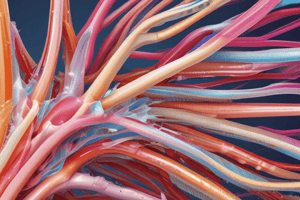Podcast
Questions and Answers
What is the primary component of tendons?
What is the primary component of tendons?
- Endotenon
- Lymphatic vessels
- Proteoglycans
- Collagen (correct)
Which stage of tendon injury involves increased maturation of collagen and alignment of fibrils in the direction of mechanical stress?
Which stage of tendon injury involves increased maturation of collagen and alignment of fibrils in the direction of mechanical stress?
- Inflammatory stage
- Maturation stage (correct)
- Proliferation stage
- None of the above
What is the difference between acute and chronic tendinopathy?
What is the difference between acute and chronic tendinopathy?
- Acute tendinopathy is characterized by a gradual development over time, while chronic tendinopathy is caused by a traumatic incident
- Acute tendinopathy shows signs of inflammation, while chronic tendinopathy is caused by overuse injury (correct)
- Acute tendinopathy is characterized by a disorganized healing reaction, while chronic tendinopathy shows signs of inflammation
- Acute tendinopathy involves overuse injury, while chronic tendinopathy is caused by a traumatic incident
What is the Alfredson Protocol?
What is the Alfredson Protocol?
What is the recommended treatment for a tendon rupture?
What is the recommended treatment for a tendon rupture?
What is the main component of tendons?
What is the main component of tendons?
What are the two clinical forms of tendinopathy?
What are the two clinical forms of tendinopathy?
What is the main symptom of chronic tendinosis?
What is the main symptom of chronic tendinosis?
What is the purpose of percutaneous electrolysis in tendon repair?
What is the purpose of percutaneous electrolysis in tendon repair?
What is the recommended treatment for a muscle strain in the proliferative phase?
What is the recommended treatment for a muscle strain in the proliferative phase?
Tendons are primarily made up of type II collagen.
Tendons are primarily made up of type II collagen.
The first stage of tendon injury is characterized by the recruitment of monocytes and macrophages.
The first stage of tendon injury is characterized by the recruitment of monocytes and macrophages.
Tendinosis is typically caused by a traumatic incident that tears the tendon.
Tendinosis is typically caused by a traumatic incident that tears the tendon.
The Alfredson Protocol is a conservative approach to treating tendinopathy that does not require equipment.
The Alfredson Protocol is a conservative approach to treating tendinopathy that does not require equipment.
Surgery and immobilization for 2 to 6 weeks is the recommended treatment for muscle strains.
Surgery and immobilization for 2 to 6 weeks is the recommended treatment for muscle strains.
What are the three stages of tendon injury repair and what happens during each stage?
What are the three stages of tendon injury repair and what happens during each stage?
What are the two clinical forms of tendinopathy and how do they differ?
What are the two clinical forms of tendinopathy and how do they differ?
What are the symptoms of acute tendonitis?
What are the symptoms of acute tendonitis?
What is the Alfredson Protocol and why is it effective?
What is the Alfredson Protocol and why is it effective?
What is percutaneous electrolysis and how does it promote tissue repair?
What is percutaneous electrolysis and how does it promote tissue repair?
Flashcards are hidden until you start studying




